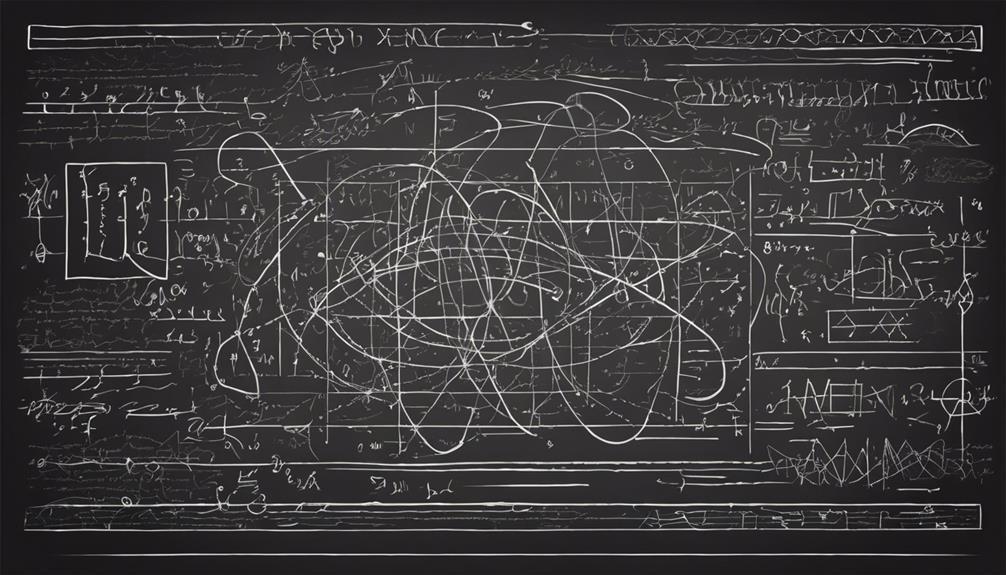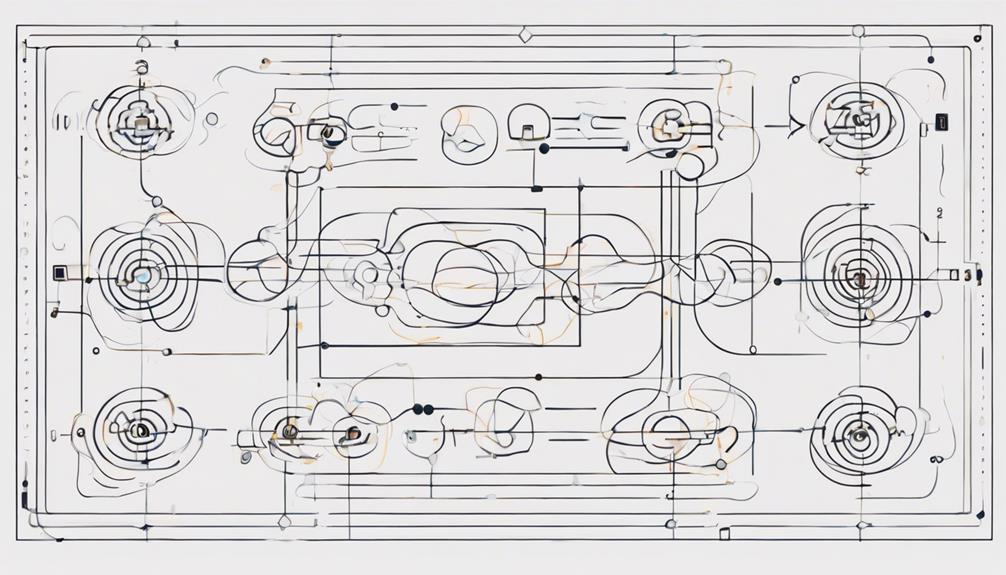Quantum mechanics, a fundamental theory in physics, challenges our conventional understanding of the universe by delving into the intricate behaviors of particles at the smallest scales. Its principles, such as wave-particle duality and quantum entanglement, have perplexed scientists and intrigued thinkers for decades. The significance of quantum mechanics extends beyond theoretical discussions to practical applications that have revolutionized technology and opened new avenues for scientific exploration. Its implications continue to shape our understanding of the cosmos and hold promise for future innovations that may redefine our technological capabilities.
Key Takeaways
- Quantum mechanics revolutionized physics with concepts like superposition and entanglement.
- It challenges classical views, enables quantum computing, and fuels technological and scientific advancements.
- Quantum phenomena like wave-particle duality and quantum tunneling redefine our understanding of the universe.
- Applications in technology, biology, chemistry, engineering, and astrophysics showcase quantum mechanics' profound impact on diverse fields.
Origins of Quantum Mechanics

In the early 20th century, a paradigm shift in physics was initiated by key figures such as Max Planck, Albert Einstein, Niels Bohr, and Erwin Schrödinger, leading to the emergence of quantum mechanics as a revolutionary framework for understanding the behavior of particles at the atomic and subatomic levels. Quantum mechanics introduced a departure from classical physics by introducing fundamental concepts like quantization, wave-particle duality, and superposition. The quantization of energy levels within atoms and the probabilistic nature of particle behavior are hallmarks of quantum mechanics that challenge the deterministic views of classical physics.
This new approach to physics not only challenged existing theories but also provided a more comprehensive understanding of matter and energy on a small scale. By incorporating probabilistic descriptions and wave-particle duality, quantum mechanics laid the foundation for modern physics. It revolutionized the scientific community's perception of the behavior of particles, paving the way for numerous technological advancements and deeper insights into the nature of the universe.
Wave-Particle Duality
The exploration of wave-particle duality within the realm of quantum mechanics presents a fundamental challenge to traditional conceptions of particle behavior, revealing a perplexing phenomenon where particles like electrons exhibit characteristics of both waves and particles simultaneously. This concept suggests that particles, such as electrons, can exhibit wave-like properties, including interference patterns typically associated with wave behavior. Such behavior contradicts classical physics theories that solely describe particles in terms of classical solid objects. The wave-particle duality is experimentally confirmed through various phenomena, notably the double-slit experiment with electrons, where electrons display interference patterns as waves do. Understanding wave-particle duality is crucial for explaining the behavior of subatomic particles, as it forms a cornerstone of quantum mechanics.
| Key Points | Wave Function | Electron |
|---|---|---|
| Description | Represents the probability amplitude of a particle's quantum states. | A subatomic particle carrying a negative elementary electric charge. |
| Behavior | Described by Schrödinger's equation, it evolves over time, determining the particle's state. | Exhibits both particle-like and wave-like properties, showcasing interference and diffraction phenomena. |
| Significance | Essential in quantum mechanics for predicting particle behavior and outcomes of experiments. | Fundamental to understanding the behavior of matter at the quantum level. |
Uncertainty Principle

Evident in the fabric of quantum mechanics, the uncertainty principle challenges classical determinism by redefining the precision of particle properties. Formulated by Werner Heisenberg in 1927, this principle asserts that the more accurately we determine a particle's position, the less precisely we can gauge its momentum, and vice versa. Rooted in the wave-particle duality of quantum mechanics, where particles exhibit dual behaviors, the uncertainty principle introduces a fundamental shift from deterministic outcomes to probabilistic predictions. By setting limits on the simultaneous measurability of certain pairs of particle properties, it introduces inherent uncertainty into quantum systems, emphasizing the intrinsic limitations in predicting outcomes with absolute precision. This principle underscores the enigmatic nature of quantum mechanics, highlighting the intricate dance between position and momentum that defies classical expectations. Embracing uncertainty as a core tenet, the uncertainty principle reshapes our understanding of the quantum realm, illuminating the nuanced interplay between fundamental properties in quantum systems.
Quantum Superposition
Quantum superposition challenges conventional understanding by asserting that particles can occupy multiple states simultaneously, a concept central to quantum mechanics. The famous Schrödinger's Cat thought experiment vividly illustrates this idea of simultaneous existence in different states until observed. Wave-particle duality further blurs the distinction between classical notions of particles and waves, paving the way for revolutionary advancements in quantum technologies.
Dual State Nature
Amidst the intricate fabric of quantum mechanics lies a perplexing phenomenon known as dual state nature, a principle that challenges conventional understanding by allowing particles to occupy multiple states concurrently. Quantum superposition, the foundation of this concept, defies classical intuition by enabling particles to exist in a combination of states until measured. This unique behavior opens the door to the potential of quantum computers, which can perform multiple calculations simultaneously due to the superposition of quantum bits or qubits. The famous Schrödinger's cat experiment serves as an illustration of quantum superposition's implications. Mastering the understanding and utilization of superposition is crucial in harnessing the immense power of quantum technologies, paving the way for groundbreaking advancements in computing and beyond.
Schrödinger's Cat Experiment
Challenging conventional perceptions of reality, the Schrödinger's Cat Experiment serves as a quintessential illustration of the enigmatic concept of quantum superposition. When delving into this experiment, several key points come to light:
- Schrödinger's Cat involves a cat enclosed with a quantum system capable of existing in multiple states simultaneously.
- Until observation occurs, the cat is considered both alive and dead, embodying the essence of superposition.
- This experiment emphasizes quantum indeterminacy, showcasing the significance of observation in collapsing superposed states.
- By showcasing the paradoxical nature of quantum superposition, Schrödinger's Cat Experiment challenges traditional views of reality and sheds light on the intricate interplay between quantum phenomena and observation.
Wave-Particle Duality
The phenomenon of wave-particle duality in quantum mechanics illuminates the dual nature exhibited by particles such as electrons, showcasing a fundamental aspect of their behavior that defies classical understanding. Quantum superposition, a key concept arising from this duality, allows particles to exist in multiple states or positions simultaneously until measured. This challenges traditional physics by demonstrating that particles can be in a combination of states until observed. The table below summarizes the essential points related to wave-particle duality and quantum superposition:
| Wave-Particle Duality | Quantum Superposition | Implications |
|---|---|---|
| Particles exhibit wave-like and particle-like behaviors. | Particles can exist in multiple states simultaneously. | Challenges classical physics. |
| Non-intuitive nature of quantum mechanics. | Crucial for understanding phenomena like interference patterns. | Highlights the dual behavior of particles. |
Understanding these concepts is vital for grasping the intricate nature of quantum mechanics.
Quantum Entanglement
Quantum entanglement, a phenomenon central to quantum mechanics, intricately links the properties of two or more particles regardless of the spatial separation between them. This mysterious connection has puzzled scientists and led to significant advancements in various quantum technologies. Here are some key points about quantum entanglement:
- Interconnected Particles: Entangled particles share correlated properties, such as spin or polarization, even when separated by vast distances.
- Instantaneous Effects: Changes to one entangled particle result in an instantaneous change in its partner, defying classical notions of locality and causality.
- Experimental Verification: Bell test experiments have confirmed the existence of quantum entanglement, showcasing the non-local nature of entangled particles.
- Practical Applications: Quantum entanglement forms the basis of quantum cryptography, enabling secure communication protocols through the use of entangled particles.
The enigmatic nature of quantum entanglement continues to fuel research and innovation in fields like quantum computing and communication. Its potential for revolutionizing secure communication and information processing makes it a cornerstone of modern quantum technology.
Quantum Tunneling

How do particles manage to penetrate energy barriers that classical physics deems impassable? This intriguing phenomenon is known as quantum tunneling, a concept deeply rooted in the principles of quantum mechanics. Quantum tunneling allows particles to traverse obstacles that, according to classical physics, should be insurmountable. This behavior is made possible by the wave-like nature of particles, enabling them to exist in multiple states simultaneously and pass through energy barriers.
In the realm of technology, quantum tunneling plays a vital role in the functionality of electronic devices such as flash memory chips. Without quantum tunneling, these devices would not operate as efficiently or effectively. Understanding and harnessing this phenomenon is essential for the development of advanced technologies like scanning tunneling microscopes, which rely on the principles of quantum tunneling to function accurately.
Quantum Computing Advancements
Quantum computing advancements have sparked both excitement and skepticism in the scientific community due to the potential for exponential computational speedup. While promising, the practical applications and limitations of quantum computing are still being explored extensively. As researchers delve deeper into this field, the development of quantum algorithms and error correction techniques remains critical for realizing the full potential of this revolutionary technology.
Quantum Computing Basics
A revolutionary shift in computational capabilities is on the horizon with the advancements in quantum computing technology. Quantum computing harnesses principles of quantum mechanics to manipulate information through qubits, paving the way for unprecedented computational power. Here are key basics of quantum computing:
- Qubits: Quantum bits can exist in multiple states simultaneously, unlike classical bits.
- Speed: Quantum computers have the potential to solve complex problems exponentially faster than classical computers.
- Challenges: Advancements focus on overcoming issues like qubit decoherence and error correction for reliable computation.
- Quantum Algorithms: These algorithms utilize quantum superposition and entanglement for parallel processing and secure data transfer.
As research progresses, the goal is to develop scalable quantum hardware and software for practical applications in various fields.
Applications in Technology
In the realm of technological advancements, the integration of quantum computing is poised to revolutionize computational capabilities. Leveraging the principles of quantum mechanics, quantum computers utilize qubits to perform computations at an exponential speed compared to classical computers. Applications of quantum mechanics in quantum computing include algorithms like Shor's algorithm, enabling efficient factorization of large numbers, and quantum teleportation for secure information transfer between distant locations. These advancements rely on quantum properties such as superposition and entanglement for parallel processing. Moreover, the implementation of quantum error correction techniques ensures reliable computation within quantum systems. The potential of quantum computing to solve complex problems and optimize processes underscores its significance in advancing technology.
Quantum Mechanics in Technology

The advancement of modern technology hinges significantly on the intricate principles of quantum mechanics. Understanding the role of quantum mechanics in technology is crucial for grasping the functioning of various devices and systems. Here are some key points highlighting the influence of quantum mechanics in technology:
- Devices Utilizing Quantum Phenomena: Technologies like lasers, MRI machines, and smartphones heavily rely on the principles of quantum mechanics for their operation.
- Electron Wave Nature in Smartphones: The wave nature of electrons, a concept derived from quantum mechanics, is fundamental for the operation of smartphones and other electronic devices.
- Quantum Computing: Quantum mechanics enables the development of quantum computers and networks, offering new possibilities for storing and transferring information with unprecedented efficiency.
- Applications in Various Technologies: Technologies such as lasers, light-emitting diodes, and medical imaging devices harness the principles of quantum mechanics to function effectively and efficiently.
Quantum Mechanics in Biology
Quantum mechanics, though a powerful tool in understanding physical phenomena, has sparked controversial debates regarding its role in biological systems. While some researchers argue for the existence of quantum effects in cells, others remain skeptical about the implications of quantum mechanics in biology. As the field of quantum biology continues to evolve, exploring the potential quantum interactions within biological processes remains a complex and intriguing area of study.
Quantum in Cells
Exploring the intersection of quantum mechanics and biological systems reveals intriguing insights into the fundamental processes governing cellular functions. In the realm of quantum biology, researchers are uncovering the impact of quantum effects on various biological phenomena. Here are some key points to consider:
- Quantum mechanics in biology delves into phenomena such as quantum coherence in photosynthesis processes.
- Studies suggest that quantum effects play a crucial role in biological processes, including enzyme reactions.
- Quantum biology aims to understand how quantum phenomena may influence biological functions at the molecular level.
- Quantum tunneling is being explored as a potential mechanism to elucidate biochemical reactions within cells.
Understanding these quantum effects in biological systems holds the promise of unlocking new perspectives on cellular processes and functions.
Biological Quantum Effects
Examining the intricate interplay between quantum mechanics and biological processes sheds light on the underlying mechanisms governing cellular functions. Quantum mechanics in biology delves into phenomena such as photosynthesis and enzyme reactions at the molecular level. Biological systems harness quantum effects for processes like energy transfer and molecular recognition, utilizing quantum coherence to facilitate efficient energy transport and information processing. Quantum tunneling plays a role in enzymatic reactions, reducing activation energies for reactions to occur. By understanding these quantum effects in biological systems, researchers gain valuable insights into fundamental processes like DNA replication and cellular signaling. These studies highlight the significance of quantum mechanics in unraveling the complexities of biological systems and their functions.
Quantum Biology Research
The investigation of biological systems through the lens of quantum mechanics offers a unique perspective on the intricate workings of cellular processes. Quantum biology research delves into the role of quantum mechanics in biological processes, shedding light on phenomena like photosynthesis and bird navigation. Understanding quantum mechanics in biology holds the potential for significant advancements in medicine and biotechnology. Researchers focus on studying how quantum phenomena influence biological systems at the molecular level, highlighting the crucial role of quantum mechanics in unraveling the mysteries of complex biological processes.
- Quantum biology research explores quantum mechanics' role in biological processes.
- Quantum effects in biology encompass phenomena such as photosynthesis and bird navigation.
- Understanding quantum mechanics in biology can lead to advancements in medicine and biotechnology.
- Researchers investigate how quantum phenomena impact biological systems at the molecular level.
Quantum Mechanics in Chemistry
Quantum mechanics plays a pivotal role in modern chemistry through its application in computational methods such as QM/MM simulations for analyzing chemical reactions and biomolecular interactions. By integrating quantum mechanics with molecular mechanics in hybrid QM/MM methods, researchers can accurately model enzyme-catalyzed reactions, providing valuable insights into the intricate processes at play. Quantum mechanics is crucial for predicting the stability of various structures, identifying active species, and investigating reaction mechanisms in catalysis studies. These QM/MM approaches are extensively employed to study bond processes, structure-function relationships, and energy components within biomacromolecules. Furthermore, quantum mechanics applications in chemistry extend to predicting unconventional structures under different external conditions and elucidating phenomena at the molecular level. The precision and versatility of quantum chemistry make it an indispensable tool for understanding and manipulating chemical systems, paving the way for advancements in various fields of chemistry.
Quantum Mechanics in Engineering

Integrating quantum mechanics into engineering disciplines revolutionizes the design and optimization of cutting-edge technologies, shaping the landscape of modern innovation in semiconductor devices, quantum computers, and communication networks. Engineers harness the power of quantum mechanics to drive advancements in various fields, including:
- Semiconductor Device Design: Quantum mechanics enables engineers to create more efficient and powerful semiconductor devices like transistors and diodes through precise control of electron behavior at the quantum level.
- Advanced Technologies Development: The application of quantum mechanics in engineering paves the way for the development of revolutionary technologies such as quantum computers and quantum communication networks, offering unprecedented computational capabilities and secure communication channels.
- Cutting-edge Fields Exploration: Understanding quantum mechanics is essential for engineers exploring frontiers like nanotechnology and quantum engineering, where manipulation of quantum phenomena is fundamental to technological progress.
- Enhanced Device Performance: By leveraging quantum mechanical principles, engineers enhance the efficiency and performance of electronic devices, pushing the boundaries of traditional engineering disciplines to create innovative solutions that drive technological evolution in diverse industries.
Quantum Mechanics in Astrophysics
In the realm of astrophysics, the application of quantum mechanics uncovers the intricate behaviors of cosmic entities and phenomena. Quantum mechanics plays a vital role in elucidating the behaviors of particles and waves on a cosmic scale, offering insights into the quantized properties exhibited by celestial objects such as stars, black holes, and galaxies. This field of study is instrumental in comprehending complex phenomena like quantum fluctuations in the early universe, shedding light on the fundamental aspects of cosmic evolution.
Astrophysicists leverage quantum principles to model gravitational interactions and the formation of cosmic structures, providing a deeper understanding of the universe's intricate web. By applying quantum mechanics, researchers can decipher the origins and evolution of celestial bodies and the cosmos itself. The integration of quantum mechanics in astrophysics not only enhances our comprehension of the cosmos but also enables us to explore the profound mysteries that lie within the vast expanse of the universe.
Future Implications of Quantum Mechanics

The potential advancements stemming from the principles of quantum mechanics in various technological domains are currently under rigorous scrutiny and evaluation. Quantum mechanics opens up a realm of possibilities, with future implications that could reshape the technological landscape. Here are some key areas where quantum mechanics is expected to have a significant impact:
- Quantum Computers: Quantum mechanics paves the way for the development of quantum computers, which have the potential to perform computations at speeds exponentially faster than classical computers by utilizing qubits.
- Quantum Teleportation: Enabled by quantum mechanics, quantum teleportation holds promise for secure data transfer, offering opportunities for advanced information processing and communication networks with unparalleled security.
- Quantum Cryptography: Quantum mechanics can revolutionize communication networks through secure data transmission using quantum cryptography, ensuring data privacy in an increasingly interconnected world.
- Quantum Error Correction: Techniques in quantum error correction for quantum computing ensure reliable computation for solving complex problems, addressing one of the key challenges in harnessing the power of quantum computers.
Frequently Asked Questions
How Important Is the Quantum Mechanics in Our Daily Life?
Quantum mechanics plays a pivotal role in our daily lives through its practical applications in various technologies. From ensuring the operation of electronic devices like smartphones and computers to underpinning medical imaging technologies such as MRI machines, quantum mechanics impacts our lives significantly. Its principles also drive the development of lasers, LEDs, and atomic clocks, all of which are essential in modern living. The intricate workings of quantum mechanics are woven into the fabric of our technology-driven society.
What Is Quantum Mechanics Trying to Tell Us?
Quantum mechanics strives to decipher the enigmatic quantum mysteries that underlie the behavior of particles and waves. It challenges conventional perceptions by suggesting an uncertain reality characterized by superposition and entanglement. By delving into the probabilistic nature of particle interactions, quantum mechanics aims to unravel the fundamental fabric of the universe. Through its exploration of the subatomic realm, this theory sheds light on the intricate dance between matter and energy.
Why Is It Important to Learn About Quantum Mechanics?
Understanding quantum mechanics is crucial for grasping the fundamental nature of matter and energy at the smallest scales. Learning about quantum mechanics provides insights into the structure of atoms, molecules, and the underlying principles of modern technology. Applications of quantum mechanics range from quantum computing to materials science. These breakthroughs have significant implications for future technologies and innovations. Therefore, it is important to learn about quantum mechanics to unlock its full potential.
How Is Quantum Physics Used in Everyday Life?
Quantum physics finds diverse applications in our daily lives, particularly in driving technological advancements. From quantum computing's promise to revolutionize data processing to telecommunications benefiting from quantum encryption for secure communications, the impact is profound. These applications underscore the pervasive influence of quantum mechanics in modern society. As technology continues to evolve, a nuanced understanding of quantum physics remains essential for harnessing its full potential in enhancing everyday experiences.
Conclusion
In conclusion, the implications of quantum mechanics are vast and profound, with the potential to revolutionize technology, drive scientific discoveries, and shape the future of innovation. The enigmatic nature of quantum phenomena continues to challenge our understanding of the universe, pushing the boundaries of what is known and opening up new possibilities for exploration and advancement. As we delve deeper into the mysteries of the quantum world, the possibilities for groundbreaking discoveries seem endless.
